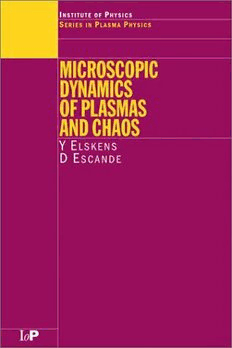
Microscopic Dynamics of Plasmas and Chaos PDF
Preview Microscopic Dynamics of Plasmas and Chaos
Microscopic Dynamics of Plasmas and Chaos Series in Plasma Physics SeriesEditors: SteveCowley,ImperialCollege,UK PeterStott,CEACadarache,France HansWilhelmsson,ChalmersUniversityofTechnology,Sweden Otherbooksintheseries PlasmaandFluidTurbulence: TheoryandModelling AYoshizawa,S-IItohandKItoh TheInteractionofHigh-PowerLaserswithPlasmas SEliezer IntroductiontoDustyPlasmaPhysics PKShuklaandAAMamun TheTheoryofPhotonAcceleration JTMendonc¸a LaserAidedDiagnosticsofPlasmasandGases KMuraokaandMMaeda Reaction-DiffusionProblemsinthePhysicsofHotPlasmas HWilhelmssonandELazzaro ThePlasmaBoundaryofMagneticFusionDevices PCStrangeby Non-LinearInstabilitiesinPlasmasandHydrodynamics SSMoiseev,VNOraevskyandVGPungin CollectiveModesinInhomogeneousPlasmas JWeiland TransportandStructuralFormationinPlasmas KItoh,S-IItohandAFukuyama Forthcomingtitles NonlinearPlasmaPhysics PKShukla FusionPlasmaDiagnosticswithmm-Waves H-JHartfuss,MHirschandTGeist Series in Plasma Physics Microscopic Dynamics of Plasmas and Chaos Yves Elskens CNRS—Universite´ de Provence (Marseilles) Dominique Escande CNRS—Universite´ de Provence (Marseilles) Institute of Physics Publishing Bristol and Philadelphia (cid:1)c IOPPublishingLtd2003 All rights reserved. No part of this publication may be reproduced, stored in a retrieval system or transmitted in any form or by any means, electronic, mechanical,photocopying,recordingorotherwise,withoutthepriorpermission of the publisher. Multiple copying is permitted in accordance with the terms of licences issued by the Copyright Licensing Agency under the terms of its agreementwithUniversitiesUK(UUK). BritishLibraryCataloguing-in-PublicationData AcataloguerecordforthisbookisavailablefromtheBritishLibrary. ISBN0750306122 LibraryofCongressCataloging-in-PublicationDataareavailable CommissioningEditor:JohnNavas ProductionEditor:SimonLaurenson ProductionControl:SarahPlenty CoverDesign:VictoriaLeBillon Marketing:NicolaNeweyandVerityCooke Published by Institute of Physics Publishing, wholly owned by The Institute of Physics,London InstituteofPhysicsPublishing,DiracHouse,TempleBack,BristolBS16BE,UK US Office: Institute of Physics Publishing, The Public Ledger Building, Suite 929,150SouthIndependenceMallWest,Philadelphia,PA19106,USA TypesetinLATEX2ε byText2Text,Torquay,Devon PrintedintheUKbyMPGBooksLtd,Bodmin,Cornwall Iknowthetendencyofthehumanmindtodoanythingratherthanthink.None ofusexpecttosucceedwithoutlabour,andweallknowthattolearnanyscience requires mental labour, and I am sure we would all give a great deal of mental labour to get up our subjects. But mental labour is not thought, and those who havewithgreatlabouracquiredthehabitofapplication,oftenfinditmucheasier togetupaformulathantomasteraprinciple.Ishallendeavourtoshowyouhere, whatyouwillfindtobethecaseafterwards,thatprinciplesarefertileinresults, butthemereresultsarebarren,andthatthemanwhohasgotupaformulaisat the mercy of his memory, while the man who has thought out a principle may keephismindclearofformulæ,knowingthathecouldmakeanynumberofthem whenrequired. (JamesClerkMaxwell, InaugurallectureatKing’sCollege, London,October1860) Permissions Figuresreprintedfrom • Phys. Plasmas 4 Be´nisti and Escande (cid:2)c1997 with permission from the AmericanInstituteofPhysics • Phys.Lett.A284Doveiletal(cid:2)c2001withpermissionfromElsevierScience • Physica D 62 Elskens and Escande (cid:2)c1993 with permission from Elsevier Science • Nonlinearity 4 Elskens and Escande (cid:2)c1991 with permission from the InstituteofPhysics • Phys. Rev. E 64 Firpo et al (cid:2)c2001 with permission from the American PhysicalSociety • Phys. Rev. Lett. 84 Firpo and Elskens (cid:2)c2000 with permission from the AmericanPhysicalSociety • Transport,ChaosandPlasmaPhysicsvol2,Guyomarc’hetal(cid:2)c1996with permissionfromWorldScientificPublishingCo vi Contents Permissions vi Preface xiii Difficultiesinthetraditionalapproach xiii Benefitsofmoderntools xv Structureofthebook xvi Prerequisitesandremarks xviii 1 Basicphysicalsetting 1 1.1 TheoriginalN-bodysystem 1 1.1.1 Physicalcontext 1 1.1.2 Theplasmamodel 2 1.2 Wave–particleresonance:aparadigmofclassicalmechanics 5 2 FromN-bodydynamicstowave–particleinteraction 10 2.1 Intuitivederivationoftheself-consistentHamiltonian 11 2.2 Langmuirwaveswithoutresonantparticles 13 2.2.1 Decompositionofthefieldandparticlemotion—relevant smallparameters 13 2.2.2 Collectivedynamics 15 2.2.3 Bohm–Grossmodes 17 2.3 Coupledmotionofquasi-resonantparticleswithBohm–Gross modes 20 2.4 Lagrangianformulation* 24 2.5 Referencestatesoftheplasma* 28 2.5.1 Non-existenceofzero-fieldstates 28 2.5.2 Thermaldistributionoftheelectricfield 29 2.6 Physicalscalingsanderrorestimates* 31 2.7 FinalformoftheHamiltonian 37 2.8 Historicalbackgroundandnotes 38 viii Contents 3 Dynamicsofthesmall-amplitudewave–particlesystem 40 3.1 Referencestatewithavanishingelectricfield 41 3.2 Smallperturbationtothereferencestate 42 3.3 Ballisticsolutions 46 3.4 Wavelikesolutions 47 3.5 Initialvalueproblem 49 3.6 Dispersionrelationforwavelikemodes 51 3.7 Physicalinterpretation:coldbeams 52 3.7.1 Caseofasinglebeam 52 3.7.2 Caseoftwobeams 55 3.8 Manycoldbeamsorawarmbeam 57 3.8.1 Landauunstablemode 57 3.8.2 Eigenmodesandinitialvalueproblem 59 3.8.3 VanKampenmodes* 61 3.8.4 Relationwithballisticeigenmodes 68 3.8.5 Transitionfromcoldtowarmbeams 69 3.9 Synchronizationofparticleswithawave 69 3.9.1 Synchronizationofparticleswithawavelikemode 69 3.9.2 SynchronizationofparticlesduringLandaudamping* 71 3.9.3 Fateofparticlesinthepresenceofmanyincoherentmodes 72 3.10 Historicalbackground 72 4 Statisticaldescriptionofthesmall-amplitudewave–particledynamics 74 4.1 Approachusingperturbationexpansion 75 4.1.1 Second-orderperturbationanalysis 75 4.1.2 Evolutionofwaves 77 4.1.3 Evolutionofparticles 81 4.1.4 Fokker–Planckequationfortheparticles 82 4.2 ApproachusingFloquetequation* 85 4.3 Linkwithtraditionaldescriptions 90 4.3.1 LandaueffectfromaVlasovianpointofview 90 4.3.2 Spontaneousemission 92 5 Hamiltonianchaos 94 5.1 GeometricaltoolsforHamiltonianchaos 96 5.1.1 Poincare´surfaceofsection 96 5.1.2 Conservationofareas,symplecticdynamicsandflux* 99 5.1.3 Action-anglevariables 101 5.2 Motionofoneparticleinthepresenceoftwowaves 103 5.2.1 Smallresonanceoverlapandcantori 104 5.2.2 Moderateresonanceoverlapandstochasticlayers 106 5.2.3 Physicalsummary 109 5.3 Constructionoforbits 111 5.3.1 Originofhigher-orderresonances 111 5.3.2 Poincare´andKAMtheorems* 114 Contents ix 5.3.3 Higher-orderresonancesfromaction-anglevariables 115 5.4 RenormalizationforKAMtori 117 5.4.1 Simpleapproachtorenormalization 117 5.4.2 Moreexplicitderivation* 119 5.4.3 Studyoftherenormalizationmapping 123 5.4.4 Thresholdsandexponents 125 5.5 Orderinchaos 129 5.5.1 WigglingarmsoftheX-point 129 5.5.2 Largeresonanceoverlap:numericalresults 133 5.5.3 Largeresonanceoverlap:analyticalresults* 136 5.6 Historicalbackgroundandfurthercomments 139 6 Diffusion:thecaseofthenon-self-consistentdynamics 141 6.1 ModelHamiltonian 142 6.2 Diffusionasanumericalfact 142 6.3 Conceptofresonancebox 148 6.3.1 Heuristicanalyticalapproach 149 6.3.2 Numericalcheckoftheconcept 153 6.3.3 Rigorousapproach* 154 6.4 Scalingpropertiesoffinite-timedynamics 156 6.5 Originoftheforcedecorrelation 158 6.5.1 Localityandresonanceboxesforrandomphases 158 6.5.2 Correlatedphases 160 6.5.3 Randominitialpositions 161 6.6 Originofthechaoticdiffusion 161 6.7 LocalityanddiffusionformoregeneralHamiltonians 163 6.8 Initialquasilineardiffusion 166 6.8.1 Non-chaoticquasilineardiffusion 167 6.8.2 Initialquasilineardiffusionuptochaos 169 6.9 Diffusioncoefficientinthechaoticregime 174 6.10 Dragcoefficient 177 6.11 Fokker–Planckequation 181 6.12 Historicalbackground 182 7 Self-consistentdynamicsinthediffusiveregime 183 7.1 Quasilineardiffusioncoefficient 185 7.2 Simplederivationofthequasilinearequations 187 7.3 Evolutionofwaves* 189 7.4 Dragonparticles* 195 7.5 Jointevolutionofparticlesandwaves 197 7.6 Saturationoftheweak-warm-beaminstability 198 7.7 Historicalbackgroundandfurthercomments 203
